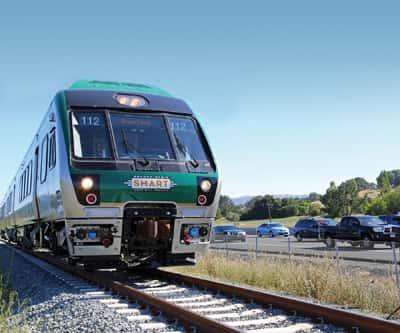NorthBay biz shines a spotlight on the economy and culture of Napa County.
A 2013 Visit Napa Valley study found that, of the many reasons people from all over the world choose to visit the region, first on the list is the area’s natural beauty, closely followed by wine, food, and, then, farther down, the rest of the lifestyle amenities. What the casual visitor may experience—but not see—is what keeps the place coherent: the love for the land and the shared dedication to maintaining a sustainable balance for the benefit of the whole. Maintaining this delicate balance, like the balance in a fine wine, is always a work in progress.
As NorthBay biz takes the measure of where Napa County stands at the start of 2014, we’ll consider some of the major issues and some of the ways the community is managing to work together to maintain the balance essential to all. We’ll start, as visitors do, with the land and end with what may (to some) come as a surprise: how Napa County is making a national name for itself not only in wine and lifestyle but in the success of its innovative educational model.
First the land
The Napa Valley brand, literally, comes with the territory. Geographically blessed with soil and climate and topographical coherence, thanks to the embrace of the Vaca Range on the east and the Mayacamas to the west, Napa Valley, with its (usually) quiet river and picturesque vineyards, is commonly referred to by those who live here as a paradise. And like the original paradise, there are threats, some of which are generated by the very success of the valley itself.
To maintain the integrity of Napa’s biodiversity, scenic views and agricultural character, the Napa Land Trust, with its 1,700 active members, partners with landowners business and other nonprofits, as well as with local, state and federal agencies to preserve and protect lands into perpetuity. “So far,” says Doug Parker, Napa Land Trust CEO, “we’ve protected more than 53,000 acres and completed 150 real estate conservation projects with landowners around the county. That shows the willingness and interest of landowners to do this and our ability to work successfully with a wide range of landowners.” The rewards may be taken for granted by those who view the valley from afar, but for those who do the work, the rewards are constant and personal. “There’s nothing more tangible than land,” says Parker. “It’s something you can stand on. It’s real.”
After 37 years, Land Trust members can look back with satisfaction. At a 2013 event, Parker says, the organization honored Harold Kelly, who was on the board of the Land Trust and had helped protect a piece of land 37 years ago —“and it’s still there, just as spectacular as it was then. And because we protected the land in perpetuity, it will be there far, far into the future.” The Land Trust also honored four landowners, Francis and Eleanor Coppola, David and Nancy Garden, Bruce and Martha Attwater and Ted and Laddie Hall, who protected about 1,500 acres by donating easements on their own lands.
Napa Valley’s strong agricultural identity
Whether focusing on the land, wine, culture or the general ambiance, the miracle of Napa Valley is held together by the vision of extraordinary, ordinary people. “We’ve been really, really fortunate to have committed, dedicated people who love the valley from an agricultural standpoint, “ says Clay Gregory, CEO of Visit Napa Valley.
“The first agricultural preserve in the United States was put in place by visionary Napa Valley vintners in 1968,” he reminds us. “Robert Mondavi’s winery was only two years old at that time. And there were some really smart people who saw Napa Valley could become a developed suburb of San Francisco instead of a prime agricultural region. They put in place the Ag Preserve, which has kept the place so special in spite of the fact we’re so near a major metropolitan area.”
St. Helena grower Andy Beckstoffer, who’s been speaking out for the Ag Preserve for more than 40 years, says that, while things are generally going well in the agricultural domain, and 2013 has been a great harvest, we shouldn’t become complacent about the brand. “These days, we’re crushing too many non-Napa grapes,” he says, “and that has an effect not only on the Ag Preserve but on the Napa brand.” He explains that a visitor can purchase a wine in the valley, expect it to be a genuine Napa Valley wine, and not notice it’s made with “California Cabernet,” not “Napa Valley Cabernet.” It’s not an outright deception, he says, but it gives a deceptive impression. “What you see is not what you get—and that’s bad.”
His second concern is for the health of the Ag Preserve itself. “The hospitality functions at wineries are out of balance with their production facilities,” he says. “Wineries are supposed to be producing wine, but they want direct-to-consumer sales. I understand that. But it gets out of balance.”
For him, the city of Napa’s move into the wine business is a very good thing. It helps the Ag Preserve and, therefore, the Napa Valley brand. “There are now 30 wine tasting rooms [in city limits],” he points out. “This is important, because as they take on the hospitality function, it relieves the Ag Preserve of the hospitality functions that have developed around wineries—and which have a major influence on traffic, environmental issues and our neighborhoods.”
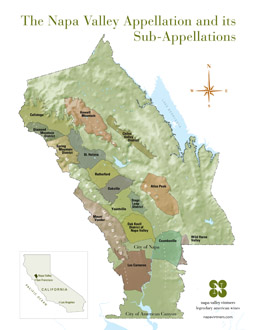 Growth with balance
Growth with balance
Linda Reiff, president of Napa Valley Vintners, says the success of Napa Valley’s wine industry is about balance. “From our perspective representing the wine industry, the culture of the valley is one that balances land and environmental preservation with business success to ensure Napa Valley’s position as one of the premiere wine regions in the world.” If the success of the organization’s annual auction is any measure, the formula is working.
Since 1981, through its Auction Napa Valley, NVV has given more than $120 million to Napa County nonprofits. In 2013, the $16.9 million raised easily topped the previous record. This is good news for the wine industry and for the community at-large. “We have this deep and beautiful philosophy of taking care of our community,” says Reiff.“I think it’s an important legacy of the Napa Valley wine industry.” Through the auction, NVV supports those local organizations that enhance the community through health care, youth development and affordable housing.
“The idea that a rising tide lifts all boats is a core value of the Napa Valley wine industry, and it’s the spirit with which our organization was founded nearly 70 years ago,” she says. “I think we’ve set an example of how an industry can come together and give back to help ensure the health and well-being of its community. We want this to be an incredible place for everyone,” she says, adding, “just look out the window, and you’ll remember we’re extremely fortunate. We have tremendous responsibility to help keep this place in amazing shape.”
Changes in the industry
Big winery sales this year have made news. The Wall Street Journal called it a “harvest” of wineries. Clos Pegase was sold to a group of investors including Dean and DeLuca owner Leslie Rudd; Mayacamas Vineyards was sold to private investor Charles Banks, former co-owner of Screaming Eagle; and Araujo Estate Wines was sold to French billionaire Francois Pinault. While three big sales may sound like a trend, Linda Reiff reminds that Napa Valley is also experiencing an increase in small brands made by wineries and winemakers who, for one reason or another, don’t own vineyards.
“I think the proliferation of small brands has been quite exciting,” she says. “We now have almost 500 wineries in our association, and that represents significant growth. But,” she adds, “80 percent of our brands produce less than 10,000 cases of wine per year.”
So, for those wanting their own brand without buying in to the traditional model—purchasing a vineyard then building a winery (making a small fortune by starting with a large one)—experienced winemakers and new enthusiasts can now create their own labels with a lower capital investment.
Practicing sustainability
NVV’s 2011 Climate Study Task Force study showed Napa Valley as unique, because it’s neither coastal nor interior but has climatic attributes of both. The study showed the valley has warmed slightly over the recent decades but not to the degree reported in broader California studies—the warming has only occurred in nighttime temperatures during winter and spring, not in daytime temperatures. “We have to remember that the wine industry is based on farming, first and foremost, and farmers will adapt to whatever change is occurring,” says Reiff.
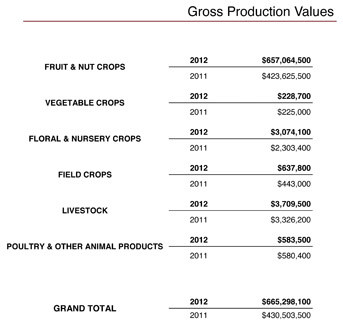 Meanwhile, she’s proud of the sustainability program promoted by NVV. The Napa Green Certified Land and Winery programs are successfully working throughout the valley. The land program was developed collaboratively by NVV, Napa Valley Grapegrowers and nearly 30 community organizations and government entities and certifies participating vineyards that work with the California Land Stewardship Institute (CLSI) to adopt “best practices” for land use (the winery program is separately certified by the county).
Meanwhile, she’s proud of the sustainability program promoted by NVV. The Napa Green Certified Land and Winery programs are successfully working throughout the valley. The land program was developed collaboratively by NVV, Napa Valley Grapegrowers and nearly 30 community organizations and government entities and certifies participating vineyards that work with the California Land Stewardship Institute (CLSI) to adopt “best practices” for land use (the winery program is separately certified by the county).Upon enrollment in the land program, participating landowners receive technical assistance and a field review, then work up a Farm Plan to consider all aspects of responsible watershed management. To be certified, the grower’s plan must be approved by a team made up of representatives from NOAA (National Oceanic and Atmospheric Administration) Fisheries, Regional Water Quality Control Board and the Napa Agricultural Commissioner’s Office.
“I think proactive efforts, like our Napa Green Certified Land and Winery programs, are good examples of how we’re leading the way to protect the valley for future generations,” says Reiff. “It’s only been 10 years, and we have more land in the Napa Green Certified Land program than is planted with winegrapes. Isn’t that cool?”
Napa Agricultural Commissioner Dave Whitmer, who retires at the end of 2013 after 33 years (the last 20 as commissioner and sealer of weights and measures) fighting pests that threaten the grape crop, leaves office on a note of satisfaction. After 13 years of vigilance, the glassy-winged sharpshooter was never really allowed a foothold in the county. Whitmer credits the success of remaining free of the pest to the county’s cooperation with measures the Ag Commissioner has put in place, including regulation of ornamental nursery stock. But that’s only part of the good news.
“Controlling the movement of the insect vector was really the sprint,” says Whitmer. “The marathon was finding a cure for Pierce’s disease, which is caused by the spread of bacteria carried by the glassy-winged sharpshooter, blue-green sharpshooter and other [related insects].” Pierce’s disease is devastating to vineyards and, so far, incurable, but there’s progress on that front, says Whitmer. “We’re probably only several years away from the nurseries being able to reproduce and sell commercially some grapevine plant material that will hold some resistance to Pierce’s disease—and that’s amazing. If we could find a cure for Pierce’s disease, we wouldn’t care as much about the glassy-winged sharpshooter or other vectors.”
The most recent problem, following the protests over the proposed 2009 light brown apple moth program (citizens across the state decried the lack of environmental studies in advance of widespread aerial spraying), was the European grapevine moth, which fed not on leaves, but on the flower and fruit itself, often leaving behind deadly fungi and bacteria on the clusters. (It’s the infamous insect seen throughout the county on “Kick the Moth Out!” billboards.) The Ag Commission trapped more than 100,000 European grapevine moths in 2009, in virtually every part of Napa County. By 2013, after containment measures had been put in place, it trapped only 40 moths in several remote areas. Clearly, the program worked. What was the magic?
“I tried to learn lessons from the light brown apple moth days,” Whitmer says, referring to the passionate protests against and distrust of the proposed containment measures, “to reach out to the community, lay out what I thought the options were and gain some understanding from them as to what direction the whole community thought was the right way to go. And then we incorporated those recommendations as best we could into our program. I think it worked out well to include everybody and it’s helped us implement a program without opposition.”
Visit Napa Valley
The economic slump of 2009 took its toll on the tourist industry, with lodging revenue down by 20 percent. But every year since then, according to Visit Napa Valley’s CEO Gregory, the industry has rebounded in double digits. “August is always a big month for us,” he says, “and this year was just phenomenal.” According to Gregory, the total revenue for was up by 14.9 percent over last year, and the overall year-to-date tally was up by 13.2 percent. “It’s amazing how well things are going.”
He credits this increase not to additional rooms or new hotels but rather to existing hotels that have been able to raise their rates and still build occupancy, “which is the best of all worlds!” One of his organization’s key ongoing promotion efforts is to encourage corporations and appropriate associations to come to Napa Valley for retreats and conferences, and enjoy the amenities—golf, hiking, biking, balloon rides, wineries and restaurants—while they’re here. He says that, as overnight weekday visitors, groups are good business. Plus, they’re easier on the local traffic and great for local restaurants.
He’s also quick to point out that not many people realize the entire West Coast has only two three-star Michelin-rated restaurants—and those two are in Napa Valley: The French Laundry (Yountville) and the Restaurant at Meadowood (St. Helena). “In our tiny little valley! It’s incredible,” he says. There are no two-star restaurants here, but the 2014 Michelin Guide lists five one-star restaurants in Napa Valley: Auberge du Soleil (Rutherford), Bouchon (Yountville), La Toque (Napa), Solbar (Calistoga) and Terra (St Helena), and there are five Bib Gourmand restaurants, defined as “inspectors’ favorites for good value”: Bistro Jeanty (Yountville), C Casa (Napa), Oenotri (Napa), Cook (St. Helena) and Redd Wood (Yountville). “This is the most stars per capita of any wine region in the world,” says Gregory, laughing. “And 20 years ago, Michelin didn’t even know the United States had restaurants!”
The Visit Napa Valley’s public relations effort, which includes all Napa County areas under the Napa Valley brand name—including Lake Berryessa (the tourist identity of which, he says, is “a work in progress”)—includes a firm based in New York as well as a local PR agency, and the brand seems to have settled down. What was once the “Conference and Visitors Bureau (CVB)” and then the “Destination Council” as of last year, is now officially “Visit Napa Valley,” which gets right down to business.
“Both Alice Marshall Public Relations [New York] and Fuller & Sander [Napa] have just been rocking it,” says Gregory. This year, Napa Valley enjoyed the excitement of being the official wine region of the 34th America’s Cup. So everyone coming to watch the race from the vantage point of America’s Cup Park in San Francisco could stop in the Napa Valley Wine Lounge (where only Napa Valley wine was served). The America’s Cup website gives all partners a separate page, and the Napa Valley page is dazzling, with video and links to Visit Napa Valley and NVV.
Destination marketing is a fast-moving science, with ever-increasing flexibility provided by smartphone apps. Gregory has been has been working to make it absolutely easy to do things like book a hotel or restaurant. “We did our first app three years ago and, at the time, it was kind of pioneering,” he says. But a new app should come out by the time this article goes to press. “It will still be called Visit Napa Valley, and it will be aesthetically better and more easy to use than the app we had before,” he says. He sees mobile apps as the way of the future for easy access to information and making connections.
 City of Napa
City of Napa
Gregory isn’t alone in looking forward to the activity and excitement that several approved developments will bring to the city of Napa. Todd Zapolski’s Shops at Napa Center will bring attractive retail, dining and lodging to downtown, which will enhance the daytime experience of visitors and locals alike. The development of several new hotels, including the St. Regis in Napa and a couple in St. Helena and Calistoga, will attract the desirable overnight visitors. And he says he has hopes the former Copia will be developed in a way that will add to the livability and draw of downtown. “There are at least two different efforts moving along to turn Copia into something sustainable, with an eye toward the original Robert and Margrit Mondavi vision of it being a center for wine, food and the arts.”
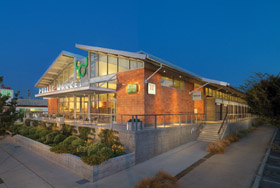 Just up river from the former Copia, the Oxbow Public Market has become a thriving, year-round marketplace for wine, food, browsing and gathering, dining and occasional music or film viewing. Specialty artisan purveyors offer meats, seafood, teas, oils, wine, cheese, organic produce, baked goods, coffee and more, and founder and CEO Steve Carlin credits its success to a harmonious partnership between the proprietor, tenants and community. “We know why people come here,” he says. “You can’t find a more beautiful place to live or visit, and I think the Oxbow is a microcosm of all the good things Napa Valley is and wants to be.”
Just up river from the former Copia, the Oxbow Public Market has become a thriving, year-round marketplace for wine, food, browsing and gathering, dining and occasional music or film viewing. Specialty artisan purveyors offer meats, seafood, teas, oils, wine, cheese, organic produce, baked goods, coffee and more, and founder and CEO Steve Carlin credits its success to a harmonious partnership between the proprietor, tenants and community. “We know why people come here,” he says. “You can’t find a more beautiful place to live or visit, and I think the Oxbow is a microcosm of all the good things Napa Valley is and wants to be.”Don’t forget the arts
“The best thing to have come along in the last 12 to 18 months,” says Olivia Everett, CEO of Arts Council Napa Valley, “is the support we’re experiencing as the result of wineries and the hospitality industry incorporating art into their business strategies.” She says some of the more cutting-edge vintners understand that now, with more than 500 wineries and hundreds of tasting rooms, the idea of diversifying the visitor experience with specialized tours and vacations plays nicely into what the culture of Napa Valley is about. “The shared strategy between Visit Napa Valley and the Arts Council is to promote wine, food and the arts as a single concept. We’re really excited about that.”
An example of how this works is the partnership between City Winery, a live music, culinary and wine oriented experience with venues in New York and Chicago and Napa, which is creating a partnership with Napa Valley Opera House. The new, combined venue is due to open in 2014. City Winery will be given a long-term lease, which will let the Opera House nonprofit scale back its administration but still keep 75 performances per year for community programming.
City Winery will maintain the historic building, devoting the downstairs to a full restaurant and restoring the performance floor of the auditorium back to its original, cabaret-style seating, so people can see shows while dining. Everett says this partnership can be a model for the future regarding how to combine community programming and sustainable revenue for profit. “We have a tremendous amount of talent, creativity and ideas here in the valley,” she says, “I’m excited to see more sustainable growth in the arts, and I hope people watch out for it.”
As the city of Napa’s image as a sleepy, small town gradually dissolved into the awakening hipness of the current downtown scene, the idea of a headline-grabbing, ear-drum blasting rock festival in the summer of 2013 created a combination of anticipation and dread, usually circling around the question: “Can Napa handle all this excitement?”
The answer seemed to be—even with the inevitable, “first-festival” kinks (crowd management problems, traffic problems, scheduling, pricing and occasional sanitation problems)—a reserved Yes. But, after the boom of the amps died down, BottleRock producers delivered a shock: $2.5 million in unpaid bills. Will the organizers ever pay the city, unions, numerous vendors and workers who made the festival rock? Will the many worthy Napa nonprofits, promised $1 million in donations, ever see checks?
At this writing, no payments are on the horizon. Yet ticket sales for 2014 were announced on the BottleRock website shortly after the first one ended.
Getting from here to there
“A lot of things are going well in Napa County right now,” says Supervisor Bill Dodd. “Our economy has come back and our agritourism business is up. With that comes transportation challenges. We have 29,000 people in our workforce who are commuting from the south every day to work in Napa. Those drivers merge with tourists and others, and the congestion down in South County is very evident. Our transportation corridors are pretty well stacked up right now. We need to be working with Metropolitan Transportation Commission [MTC] and the state to determine solutions.”
In an effort to get a handle on the valley’s traffic patterns, the Napa County Transportation and Planning Agency (NCTPA) is conducting a travel behavior study that tracks car movements via cell phone GPS data. “We’re looking at cell phone data to see where the traffic is coming in and where it’s going out,” says NCTPA Executive Director Kate Miller. “We’re sending license surveys out to both the people who live here and who’ve visited here, so we understand why they came, when they arrived, how long they stayed and what they did when they were here, so we get a better feeling for how we might design our transportation system around that.”
This kind of tracking has drawn fire from people concerned about privacy, but Miller says measures have been put into effect to safeguard confidentiality. “We understand privacy is a critical right,” she says, “and we don’t want to violate that. At the same time, we need this information to really understand how we’re going to deploy transportation resources.”
NCTPA is also looking for ways to encourage system users to change travel behavior, and reduce the congestion by reducing the number of cars. “We’re looking in to things like car and bike sharing. We have several routes that connect people to BART, Amtrak and the Vallejo ferry on weekdays; that infrastructure already exists. We’re going to want to give some thought to what we can do on the weekends to accommodate visitors. That’s another thing we’ll look at as part of the countywide plan.”
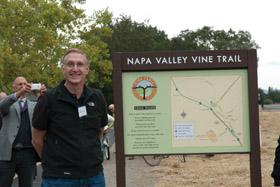 The Napa Valley Vine Trail Coalition, with 40 board members and more than 80 volunteers, has worked for the last five years to create a safe trail for bikers and walkers from Napa all the way north to Calistoga. Supported by NVV, NVGG and Napa Land Trust and led by the tech-visionary-turned-vintner Chuck McMinn, the Vine Trail plans to create 14 continuous miles of trails for walking and biking from Napa to Yountville in 2014.
The Napa Valley Vine Trail Coalition, with 40 board members and more than 80 volunteers, has worked for the last five years to create a safe trail for bikers and walkers from Napa all the way north to Calistoga. Supported by NVV, NVGG and Napa Land Trust and led by the tech-visionary-turned-vintner Chuck McMinn, the Vine Trail plans to create 14 continuous miles of trails for walking and biking from Napa to Yountville in 2014.Groundwater issues
People in Napa Valley are never far from discussions about water. “In the area just east of Napa, we’re taking more water out of the ground for vineyards, golf courses and other uses than we’re making up with rain water, and the area is experiencing groundwater depletion,” says Supervisor Dodd. “The area just east of Napa is experiencing groundwater depletion.”
In an innovative solution to a difficult problem, the Milliken-Sarco-Tulocay Recycled Water Project will bring reclaimed water from the Napa Sanitation District out to that area to serve primarily large vineyard operations and Napa Valley Country Club. The project was hotly contested, but after several years of discussion in 2012, community members finally agreed to form the Community Facilities District (CFD) to finance the pipeline.
“We’ll start seeing construction sometime in 2014,” says Dodd, with satisfaction. “It’s always very easy to kill projects because of naysayers. But Supervisor Keith Caldwell has been a driving force behind this. He’s done a great job building consensus and getting us where we are today. He’s done an incredible amount of work.”
Caldwell says the county hopes to be laying that pipe in the summer of 2014. “We’ve received all our federal share for that project, and we’re going forward.” The project will use recycled water in place of the 200 acre-feet of groundwater that Napa Valley Country Club pumps annually for irrigation. The entire recycled water project will provide up to 700 acre feet of recycled water annually.“This will take the largest ‘straws’ out and will allow for an eventual, natural recharge.”
Over and over, when Napans talk about achieving something by reaching consensus, they refer to the work that was done to bring the community together on the Napa River flood plan in 1997. That model of consensus is alive today. “Three supervisors are still serving today who were on the board when community, business and political leaders got together to create our flood control project,” says Caldwell. “They not only left a lasting gift of a great flood plan but also gave us a great example of how to create consensus. You don’t just go in, throw something down on the table and say, ‘This is what we’re going to do.’ You have to get buy-in from all sectors of the community.”
Like the flood project, the Milliken-Sarco-Tulocay Recycled Water Project is a model of innovation and collaboration. “We banded together with our two adjoining counties, Marin and Sonoma, to get this done,” says Caldwell. “I’ve been to Washington, D.C., at least 6 times advocating for this project, and it’s being used as a model for how Washington, D.C., and the Bureau of Reclamation, our sponsor in this program, want to see business done.”
The project shows the county’s ability to come together as a community to address a problem of a depleted water table by creating a supply that conserves. “I’m from American Canyon,” says Caldwell, referring to the area in Napa County with the greatest population growth since the late 1980s, “and I think people should know how fragile the balance is that we have in this county between agriculture and urban sprawl. That balance is under attack almost on a daily basis. I think the current board—and previous boards—have resisted the temptation to just approve development or change zoning. Instead, we’ve fought the hard fight, and I think it’s really paid off.”
Development changes and a looming threat
Larry Florin, director of housing and intergovernmental affairs for Napa County, says the long-disputed Napa Pipe development is on its way to resolution to provide affordable, multi-family housing to satisfy the requirements of the state. “We’ve turned the corner in terms of working cooperatively among the county’s separate jurisdictions and with the developer to approve and, hopefully, get a project built that all of us can be happy with and proud of,” says Florin. “We hope the days of adversarial confrontations about this project are over.” In November, the board of supervisors signed an approval for a term sheet between the county and Napa Redevelopment Partners, which advances the project a step closer.
They’re working on a Development Agreement, design plans and hope to get the project approved in early 2014.
Supervisor Diane Dillon notes the county’s proposed plan to move the jail, now in downtown Napa, to an area on the outskirts of town as a positive development. “The current jail was built before we realized the extent to which substance abuse issues would contribute to criminal activity and, of course, well before the state implemented “Realignment” to keep more offenders in local jails rather than in state prisons.
“We believe we can run [the new jail] in a more progressive and cost-effective way,” she says. “We’ve implemented a very progressive, evidenced-based system for managing prisoners and trying to give them opportunities to better themselves, so we can get a grasp on the recidivism rate.”
The board is currently looking for the land and the funds to make the change happen.
Dillon also is watching for a potentially devastating blow to the Ag Preserve and the character of Napa Valley. Her concern is that, under the current federal, legal and regulatory scheme, it’s possible that a Native American group could get Bureau of Indian recognition as a tribe and have land taken into trust, which would then become a sovereign “nation” (and therefore not subject to the local land use requirements by which every other property owner in Napa County abides). According to Dillon, this is a stated desire of at least one group of Native Americans that’s currently litigating with the federal government.
“We have a very delicate watershed here,” she says. “We’ve been blessed, because of our soil and climate, to be able to produce high-quality agriculture, and we’ve been able to preserve our land for that purpose. Everybody in Napa County has to comply with Measure P, which requires [until 2048] a citizen vote to make zoning changes on agricultural and watershed lands—and that’s really all we’re asking here,” says Dillon, “and that’s really all we’re asking here.”
Health for all
The county of Napa completed a health needs assessment in 2013 and is now developing a community health improvement plan based on its findings. ”We tried to not just look at numbers of diseases,” says Dr. Karen Smith, Napa County health officer and public health division director, “but really to look at the community as a whole, from the perspective of assets and also challenges.”
One major asset in Napa County, which may not be expected on an assessment about health, is the ability of the community to develop partnerships and foster collaboration among diverse stakeholders. “This is a big strength in Napa,” Smith says. Another is people’s sense of living in clean, safe neighborhoods.
The challenges, she says, cluster around the divide between high and low income, and between the Hispanic and non-Hispanic population. “So, for example, 15 percent of Napa County residents rate their health as fair or poor, as opposed to excellent or good,” she says. “But if you look at Hispanic and low-income residents, the percentage rating their health as less than excellent or good will be much higher.” Educational and economic challenges, limited mental health services and alcohol and drug abuse, particularly among the youth, all contribute to the disparities in health outcomes. “Some numbers in there are staggering,” she says. Finally, overweight and obesity is another major challenge. Education can be a plus, along with income and culture. “We know that people who graduate from high school have overall better health status as adults.”
The four priority areas of the Health Improvement Plan are to improve wellness and healthy lifestyles; create and sustain partnerships for collective impact; ensure access to high quality health care and social supports across the life course; and to address the social determinates of health, such as income, poverty, housing and educational attainment. To achieve these goals, the Live Healthy Napa County collaborative will continue to find new ways to strengthen existing and create new partnerships, including with the community, for even greater “collective impact.” Smith says, so far, about 30 organizations have formed “a pretty robust collaborative” that encompasses all aspects of the county and includes health providers from hospitals, governmental agencies, mental health providers as well as the nonprofit sector.
Because health is an integral factor in all aspects of the county’s functioning, the core group includes the Napa County Transportation and Planning Agency, the Office of Education, law enforcement, the business community and even the Farm Bureau. It includes the county, all six city governments, Napa Valley College, representatives of the faith community, a number of nonprofits that work on educational attainment and health, Emergency Women’s Services, among many others. The core support team includes Queen of the Valley Community Outreach, St. Helena Hospital Community Outreach, Kaiser Community Outreach, the Health and Human Services Agency and the Napa Coalition of Nonprofits, which has been part of the core support team from the start. The huge task going forward is assuring access to high-quality health services and social support across the life course for everyone in Napa County.
“We’re lucky,” Smith says, “because Napa County has a strong culture of philanthropy, and we have some very prominent philanthropic organizations that have donated early on in this process.”
Among key supporters are groups working to further the educational interests of all children in Napa County, so all students in Napa County schools can be prepared for college, careers and lives that are, by the health assessment’s standards, conducive not only to economic success, but to health.
In Napa County, leaders in the public education system are grappling with the same challenges facing schools all over the country—and particularly in the Napa Valley Unified School District—and are tackling the issue head-on in an innovative, transformative way.
New school model
“It’s a renaissance in education,” says Napa Valley Unified School District Superintendent Patrick Sweeney of the new model being practiced in classrooms throughout the county. “It’s amazing: Teachers are excited; they’re seeing the excitement in their students; and they’re all learning new things.”
Anyone walking into one of the transformed classrooms in the Napa Valley School District will see a new configuration—no teacher in front, no kids dozing in rows—and they’ll feel the energy, whether in kindergarten, where children are helping each other learn language and math on iPads, or in middle school or high school where groups of students, armed with their laptops and devices, are learning from experience and working together to find answers, create solutions or present the results of their “real-world” research projects to an audience of teachers, peers and guests. The energy the visitor experiences is the buzz of Project Based Learning.
 “We’re trying to make sure all students can master the new Common Core State Standards by being proficient in the four ‘C’s’—critical thinking, communication, creativity and collaboration,” says Sweeney. Yes, one might wonder, but does it work? Last year, he points out, the College Work Readiness Assessment showed that students at Napa New Technology High School improved 207 percent more than comparison students in measures of deeper learning between freshman and senior years, a high predictor of college and career success.
“We’re trying to make sure all students can master the new Common Core State Standards by being proficient in the four ‘C’s’—critical thinking, communication, creativity and collaboration,” says Sweeney. Yes, one might wonder, but does it work? Last year, he points out, the College Work Readiness Assessment showed that students at Napa New Technology High School improved 207 percent more than comparison students in measures of deeper learning between freshman and senior years, a high predictor of college and career success.The model for technology-enhanced, project-based learning was pioneered and perfected over the last 16 years at Napa New Tech High and is now being successfully adopted all over the country. Lydia Dobyns, president of New Tech Network, which has carried the model to 134 New Tech schools in 23 states and Australia, says of its success, “I think it’s because we start with the very simple premise that, if you can engage the learner because what he or she is learning is relevant, connects to the world he or she lives in now and can be viewed as an authentic way to imagine a future, then anything is possible!”
Chuck McMinn, president of NapaLearns, a nonprofit educational foundation made up of key business leaders, educators, ex-CEOs and high-tech entrepreneurs who come together to help local school districts transform to the New Tech model by providing funding, supplying technical expertise and subsidizing professional development for teachers, says that while it’s possible to spend a great amount of money to provide fine education for a small number of students, what’s needed now, in Napa and across the country, is for all students to be prepared “for a future we can’t even identify!” He says there are jobs being created, but they require skills, education and the ability to collaborate, think creatively and solve problems. Why? Because the pace of change is increasing to the point where, “[the next generation] will be required to solve problems no one has ever solved before—and that requires more education.”
It also requires a whole transformation of the way learning takes place, and McMinn believes Napa County has the talent, resources and the will to make it happen. Not only does Napa County boast three higher-education institutions: the four-year Pacific Union College in Angwin, Napa Valley College and Touro University in nearby Vallejo, but the Napa community has, as an established as part of its culture, the ability to work together to achieve creative solutions to challenges and a recognition that what’s worthwhile requires investment. The latter is a sentiment McMinn repeats loudly and often when he talks about education: It needs to be seen as an investment, not a cost. He’s optimistic for the future and says Napa has what it takes to make this transformation happen: “Our unique ability to achieve this change is because we have a strong sense of community, and we’re small enough that we can focus on this and work together to help create the solution.”
Napa: A place and an idea
Many aspects of the Napa story are missing from this survey. The dedicated work of so many nonprofits, such as The Pathway Home, which helps veterans recognize and recover from PTSD, the many sustainability groups working to keep Napa healthy and green, not to mention the all stories of people who make a difference on a daily basis to make Napa County what it is. But all would probably echo the same sentiments: That it’s community, collaboration and everyone bearing their share that makes and keeps this a great county. As community leader Dorothy Salmon, who has, since the Flood Plan days, succeeded in bringing people together over seemingly impossible issues, says, “Napa typifies possibility thinking in spades. We ask, ‘Why not?’ instead of ‘Why?’”


